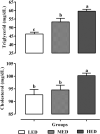Impact of high dietary energy on obesity and oxidative stress in domestic pigeons
- PMID: 33811747
- PMCID: PMC8294395
- DOI: 10.1002/vms3.478
Impact of high dietary energy on obesity and oxidative stress in domestic pigeons
Abstract
Obesity is associated with increased risk of oxidative stress in humans and laboratory animals but information regarding obesity-induced oxidative stress in birds is lacking. Therefore, this study aimed to investigate the influence of high-energy diets (HED) on obesity and oxidative stress in domestic pigeons. Forty-five adult clinically healthy-domestic male pigeons were randomly assigned to three equal dietary groups including low (2,850 kcal/kg), medium (3,150 kcal/kg) and high (3,450 kcal/kg) energy diets (named low energy diet, medium-energy diet and HED, respectively). All birds received formulated diets for 60 consecutive days. Several parameters such as feed intake, body weight (BW), average weight gain (AWG) and total weight gain were determined. Serum concentrations of triglyceride (TG), total cholesterol (TC), high-, low- and very-low-density lipoprotein cholesterols, alanine aminotransferase (ALT), aspartate aminotransferase (AST) and alkaline phosphatase (ALP) were evaluated at days 0, 30 and 60; and serum levels of total antioxidant capacity (T-AOC), malondialdehyde (MDA) and cortisol were also measured at day 60. On day 60, five pigeons from each group were randomly euthanized and some parameters such as weight and relative weight of liver, breast muscle, and abdominal fat were determined. Furthermore, hepatic total fat content was also evaluated. BW, AWG, total weight, and circulating TG, TC, ALT, AST, ALP, MDA and cortisol in HED were significantly higher than other groups. Serum T-AOC in HED was significantly lower than the other groups. In conclusion, this study showed that increasing dietary energy up to 3,450 kcal/kg in pigeons led to obesity and oxidative stress in them. Accordingly, it could be stated that HED and obesity induce oxidative stress in pigeon and controlling the dietary energy intake of pigeons is necessary to prevent oxidative stress in them.
Keywords: dietary energy; obesity; oxidative stress; pigeon.
© 2021 The Authors. Veterinary Medicine and Science published by John Wiley & Sons Ltd.
Conflict of interest statement
The authors declare no conflict of interest.
Figures


Similar articles
-
Beneficial effects of cocoa, coffee, green tea, and garcinia complex supplement on diet induced obesity in rats.BMC Complement Altern Med. 2016 Mar 12;16:100. doi: 10.1186/s12906-016-1077-1. BMC Complement Altern Med. 2016. PMID: 26968378 Free PMC article.
-
Prophylactic effects of dietary ascorbic acid on oxidative stress indices, physiological and behavioural responses of domestic pigeons exposed to road transport stress.Vet Med Sci. 2021 Nov;7(6):2389-2398. doi: 10.1002/vms3.609. Epub 2021 Sep 15. Vet Med Sci. 2021. PMID: 34797959 Free PMC article.
-
Effects of parental dietary linoleic acid on growth performance, antioxidant capacity, and lipid metabolism in domestic pigeons (Columba livia).Poult Sci. 2020 Mar;99(3):1471-1482. doi: 10.1016/j.psj.2019.11.002. Epub 2020 Jan 28. Poult Sci. 2020. PMID: 32111316 Free PMC article.
-
Simvastatin and vitamin E effects on cardiac and hepatic oxidative stress in rats fed on high fat diet.J Physiol Biochem. 2013 Dec;69(4):737-50. doi: 10.1007/s13105-013-0250-y. Epub 2013 Apr 12. J Physiol Biochem. 2013. PMID: 23580160
-
Optimal dietary energy and protein levels for breeding pigeons in the winter "2 + 3" lactation pattern.Poult Sci. 2023 Oct;102(10):102964. doi: 10.1016/j.psj.2023.102964. Epub 2023 Jul 26. Poult Sci. 2023. PMID: 37573846 Free PMC article.
Cited by
-
Walking and taking vitamin C alleviates oxidative stress and inflammation in overweight students, even in the short-term.Front Public Health. 2022 Oct 5;10:1024864. doi: 10.3389/fpubh.2022.1024864. eCollection 2022. Front Public Health. 2022. PMID: 36276369 Free PMC article.
-
Effects of dietary stinging nettle (Urtica dioica) on hormone stress and selected serum biochemical parameters of broilers subjected to chronic heat stress.Vet Med Sci. 2022 Mar;8(2):660-667. doi: 10.1002/vms3.721. Epub 2022 Jan 12. Vet Med Sci. 2022. PMID: 35023316 Free PMC article.
-
Effect of Dietary Energy Levels on the Reproductive Performance in Breeding Pigeons, and Growth Performance and Intestinal Health in Squabs.J Poult Sci. 2025 Apr 22;62:2025015. doi: 10.2141/jpsa.2025015. eCollection 2025. J Poult Sci. 2025. PMID: 40264516 Free PMC article.
-
Potential for the development of Taraxacum mongolicum aqueous extract as a phytogenic feed additive for poultry.Front Immunol. 2024 Mar 11;15:1354040. doi: 10.3389/fimmu.2024.1354040. eCollection 2024. Front Immunol. 2024. PMID: 38529273 Free PMC article.
-
Effects of dietary metabolizable energy density and inclusion of oxidized soybean oil on the growth performance, serum biochemical parameters, redox status, and wooden breast incidence of broilers.J Anim Sci. 2025 Jan 4;103:skaf086. doi: 10.1093/jas/skaf086. J Anim Sci. 2025. PMID: 40114330
References
-
- Abouelezz, K. F. M. , Wang, Y. , Wang, W. , Lin, X. , Li, L. , Gou, Z. , Fan, Q. , & Jiang, S. (2019). Impacts of graded levels of metabolizable energy on growth performance and carcass characteristics of slow‐growing yellow‐feathered male chickens. Animals, 9, 461. 10.3390/ani9070461 - DOI - PMC - PubMed
-
- Aminlari, L. , Shekarforoush, S. S. , Hosseinzadeh, S. , Nazifi, S. , Sajedianfard, J. , & Eskandari, M. H. (2019). Effect of probiotics bacillus coagulans and lactobacillus plantarum on lipid profile and feces bacteria of rats fed cholesterol‐enriched diet. Probiotics and Antimicrobial Proteins, 11, 1163–1171. 10.1007/s12602-018-9480-1 - DOI - PubMed
Publication types
MeSH terms
LinkOut - more resources
Full Text Sources
Other Literature Sources
Medical
Miscellaneous

